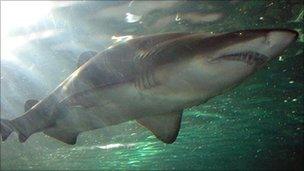Anatomical clues to human evolution from fish
- Published
It may seem strange that humans have evolved from fish, but the evidence can be found not just in fossils but also within our own bodies.
Your face is your most expressive feature; it tells the world what you are feeling, who you are and where you come from. Although no two faces are exactly the same, they share a number of common characteristics; a couple of eyes, a nose, a mouth and a philtrum.
The philtrum is the groove on your top lip that lies just beneath your nose. You see it every day in the mirror so you probably never think about it
It has no obvious function. Instead it is an accident of our origins, a clue to our fishy past and how our faces first formed.
Your face is formed in the womb in the first couple of months of life, from when you were the size of a grain of rice to when you were the size of a kidney bean.
The video (above) of a growing human face shows how this process happens. It has been created from high quality scans of human embryos at early stages of development, provided by universities and hospitals.
This unique time-lapse video shows the face developing from a one-month-old embryo to an age of 10 weeks.
If you watch it closely, you will see that the human face is actually formed of three main sections which rotate and come together in an unborn foetus.
The way this happens only really makes sense when you realise that, strange though it may sound, we are actually descended from fish.
The early human embryo looks very similar to the embryo of any other mammal, bird or amphibian - all of which have evolved from fish.
Your eyes start out on the sides of your head, but then move to the middle.
The top lip along with the jaw and palate started life as gill-like structures on your neck. Your nostrils and the middle part of your lip come down from the top of your head.
There is no trace of a scar; the plates of tissue and muscle fuse seamlessly. But there is, however, a little remnant of all this activity in the middle of your top lip - your philtrum.
This whole process, the bits coming together of the various elements to produce a recognisable human face, requires great precision.
To fuse correctly the three sections must grow and meet at precisely the right time in the womb.
If the timing is out, by as little as an hour, the baby may grow up with a cleft lip or cleft lip and palate, which can be extremely disfiguring. Around the world one in 700 babies are born with clefts.
Fishy features
There are other odd things about human anatomy that can only really be explained by our fishy ancestry.

Sharks, like other fish, have their reproductive organs in their chests
For example, if you were to cut up a shark you would discover that its gonads are lodged up in its chest, behind its liver.
Like the shark our gonads also start life high up, near the liver. But unlike the shark they need to descend.
In a woman they descend and become the ovaries, located conveniently near the uterus and the fallopian tubes
In men, they become the testes; but to get down and fill the scrotum they have to make a far longer and more tortuous journey south.
One consequence of this journey is the creation of a weakening in the abdominal wall. And as a result, men are far more prone than women to what are known as inguinal hernias.
An inguinal hernia can appear as a lump in the groin area and may be painful; the lump normally disappears if you lie down.
The lump is actually the contents of your gut protruding through that weakness in the muscle wall left behind by the descent of the testes.
Inguinal hernias often require surgery, and if you are unfortunate enough to get one, blame it on fish.
Hiccups
An American called Charles Osborne has the dubious honour of holding a record for the longest recorded bout of hiccups - 68 years worth, from 1922 to 1990. It seems that again it is our fishy ancestors who are partly to blame.
A hiccup is caused by a spasm of the diaphragm, a big muscle in the chest, followed by an involuntary gulp. Both these actions have watery roots.
In fish the nerves that activate breathing take a short journey from an ancient part of the brain, the brain stem, to the throat and gills. In us, it is more complicated.
To breathe properly, our brain stem has to send messages not just to the throat, but down to the chest and diaphragm. This complex arrangement means that the nerves are prone to spasm, which can initiate hiccups.
Once a hiccup has started, it is kept going by a simple motor reflex that we seem to have inherited from an amphibian ancestor.
For the ancient tadpole, the nerve controlling this reflex served a useful purpose, allowing the entrance to the lung to remain open when breathing air but closing it off when gulping water - which would then be directed only to the gills.
For humans and other mammals who hiccup, it has no value but does provide another bit of evidence of our common ancestry.
Dr Michael Mosley presents Inside the Human Body, Thursdays, 9pm, from 5 May on BBC 1.
- Published26 April 2011